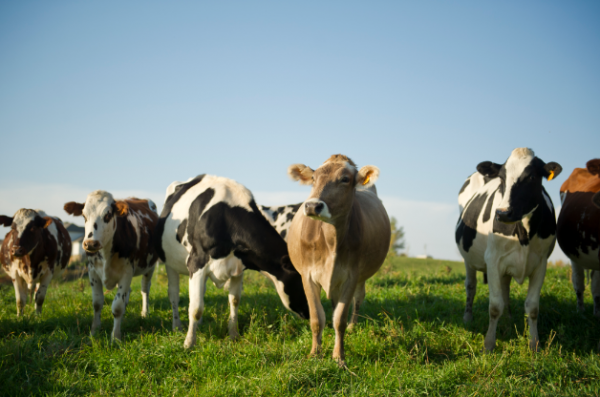The federal ministry of agriculture and rural development on Monday confirmed the outbreak of anthrax disease in some farm animals in Niger state.
This is the first recorded case of anthrax in Nigeria since its outbreak in Northern Ghana.
How concerned should you be? Here are what you should know about anthrax disease.
What is anthrax disease?
Anthrax is a rare but serious infectious disease caused by spore-forming bacteria known as Bacillus anthracis.
This bacteria occurs naturally in soil but resurfaces when the soil is disturbed by flooding, torrential rains, or deep digging.
Anthrax commonly affects domestic and wild animals when they breathe in or ingest spores in contaminated soil, plants, or water.
Humans can, however, become infected through direct or indirect contact with sick animals.
Is anthrax of different types?
Yes, there are basically four types of anthrax. The types of anthrax reflect the different ways the bacteria enter the body.
They include;
- Cutaneous anthrax: This type of anthrax occurs when bacteria infect the body through a wound in the skin. This can happen when a person handles infected animals or contaminated animal products like wool, hides, or hair. Cutaneous anthrax is most common on the head, neck, forearms, and hands. It affects the skin and tissue around the site of infection. Cutaneous anthrax is the most common form of anthrax infection, and it is also considered to be the least dangerous. Infection usually develops from 1 to 7 days after exposure.
- Inhalation anthrax: This type of anthrax is considered to be the most deadly form of the disease. Infection usually develops within a week after exposure, but it can take up to 2 months. Inhalation anthrax occurs when a person breathes in the anthrax spore. Inhalation anthrax starts primarily in the lymph nodes in the chest, before spreading throughout the rest of the body, ultimately causing severe breathing problems and shock.
- Gastrointestinal anthrax: This type affects people who eat undercooked or raw meat from an infected animal. The bacteria affect your esophagus, throat, stomach and intestines. Infection usually develops from 1 to 7 days after exposure.
- Injection anthrax: This is a newly discovered anthrax. It occurs when people inject themselves with contaminated heroin. The symptoms are similar to cutaneous anthrax but injection anthrax can spread throughout the body faster. It can also be harder to recognize and treat.
What are the symptoms of anthrax disease?
Anthrax symptoms vary depending on the type.
Cutaneous anthrax
- Raised bump on the skin
- Itchy skin
- Blisters
- Skin ulcer (sore) with a black center
Inhalation anthrax
- Cold symptoms
- Sore throat
- Fever
- Achy muscles
- Cough
- Shortness of breath
- Fatigue
- Shaking
- Chills
- Vomiting
Gastrointestinal anthrax
- Nausea and vomiting
- Abdominal pain
- Loss of appetite
- Swollen neck and throat
- Sore throat and difficulty in swallowing
- Bloody diarrhea
Is anthrax disease contagious?
No, anthrax disease is not contagious. Anthrax is not contagious like chickenpox or the flu. You cannot catch anthrax from being around someone who is infected.
You can only get it by inhaling the spores, eating contaminated meat, or having the spores come in contact with your skin.
What are the treatments for anthrax disease?
Anthrax disease can be treated using;
- Antibiotics
- Antitoxins: To neutralize anthrax toxins in the body
- Vaccine
How can anthrax disease be prevented?
The most effective way to prevent anthrax disease is by taking the anthrax vaccine.
Biothrax is the only approved anthrax vaccine by Food and Drug Administration. It is also said to be 92.5% effective.
You can prevent anthrax disease by also avoiding sick or dead animals.
Ensure food safety: Anthrax spores can be found in contaminated animal products. So purchase meat and animal products from reliable sources and ensure they are properly cooked before consumption.
People who work with animals like veterinarians and farmers should also take adequate preventive measures when handling infected animals.
How has Nigeria been managing anthrax?
The federal ministry of agriculture and rural development — in collaboration with the Niger state government — said it has taken proactive measures to ensure the outbreak is controlled and contained quickly in Nigeria.
“This include quarantine of the affected farm, deployment of anthrax spore vaccines to the affected and adjoining farms to vaccinate in-contact animals, educating the farm workers of the affected farms on symptoms, preventive measures and what to do when encounter with suspected case,” the ministry said in a statement.
“The federal ministry of agriculture and rural development hereby encourages all livestock owners to remain vigilant and promptly report any suspicious illness or deaths in their animals and to avoid contact with sick or dead animals and their products, to exercise caution when buying animals — cows, camels, sheep, goats, and other livestock — from Nigerian states bordering Benin, Chad, and Niger, and from Ghana and Togo via waterways.”
The ministry also advised against the slaughtering of farm animals at home, and eating of sick animals.
Copyright 2024 TheCable. All rights reserved. This material, and other digital content on this website, may not be reproduced, published, broadcast, rewritten or redistributed in whole or in part without prior express written permission from TheCable.
Follow us on twitter @Thecablestyle

